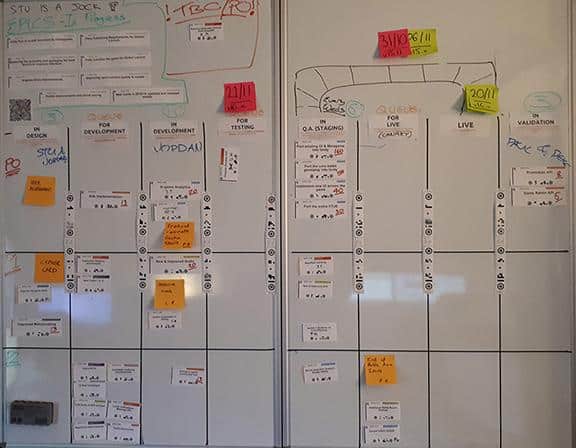I thought it might be interesting to share what a typical day is like for me at our studio. Obviously this is just one example, and one of the great things about working as a games designer is that every day brings something new and interesting, but it’ll provide a snapshot of life at a small studio.
8.30 – 10.00
I write most of these posts on the train, then the walk to the office is a mix of thinking about my day’s plans and next steps on my current painting project – in this case a pair of Warlord Titans (just how much weathering is too much?) Then tea making (essential), answering emails, and so on.
10.00 – 10.15

Behold the awe inspiring secrets of our current task list
We have a couple of standups each morning. The first is a chance for everyone working on Combat Cards to run through our taskboard – which is run Kanban style if you’re interested – and discuss progress, problems, etc.
At the moment, almost everyone is focused on getting the game ready for worldwide launch, so we discuss polish, bugs which have been addressed, sending new assets to Games Workshop for feedback, new icons, sounds and visual effects.
The second standup is a ‘Captains meeting’, for the leads of each of our projects to update each other on anything important, and coordinate staff we may need to borrow.
10.15 – 1.00
There are a couple more meetings in here (as the studio’s Design Director, I’m involved in a lot of meetings, covering things like staff, training, outsourcers and future work). But the bulk of my morning is spent preparing for the Warhammer 40,000 Open Day being held at GW’s HQ – Warhammer World. We’ll be demoing Combat Cards to our core audience, so need to ensure the latest version is as polished and bug free as possible.
These events are fun, but there are a lot of logistical issues to solve, such as accommodation, transportation, hardware needed and the ongoing quest to find the best way to display the ‘Helbrute with a hole for a head’ (yes, this is a real thing).
1.00 – 2.00
Lunchtime includes a quick shop, catching up on the day’s 40K and games news, and food. But there’s still time for hobby projects, which for me is gluing Adeptus Titanicus buildings. Other people are working on Necrons, Deathguard Killteams and complaining about my glue stinking the office out.
2.00 – 6.00
The afternoon revolves around two areas – preparing the next batches of miniatures we’re planning to add to the game, and looking at the upgrade to the game’s MMR system.
I’ve written about how we add new miniatures before, but because we add roughly eight miniatures to the game per month this is an ongoing task, which we do in batches.
Today I’m looking at what each faction needs in terms of card rarity, but also at the newest 40K releases – which is Blackstone Fortress at the time of writing. Then I check if we have high-res art for the selected miniatures, and if not, request it from Games Workshop. Finally I prepare each card’s stats, upgrades, trait, name, subtitle and background text (for the back of the card – coming soon). All this is passed to our analyst, so he can work out the card’s points cost based on its stats. The final card is sent to GW for approval, and is then ready to be unlocked at a later date.
I’m also working on our new Match Making Ranking (MMR) system, which is used to calculate who you battle against. Our current design is too simple, so can produce poor matches, meaning we need to upgrade and improve it.
Matchmaking is quite a complex area, involving a lot of factors which we need to decide if we take into account or not. For example, our cards don’t increase their points cost as they’re upgraded, so two players with the same Rank could have wildly different ‘deck power’ depending on whether they’ve made a purchase (and therefore upgraded their cards).
I’ll write more about our new MMR system once we’ve implemented it and have some data to see how it’s working, but it’s certainly sparked a lot of discussion and opinions in the studio. Part of my job is to take all that input and make the call on which direction we should go in. If you’d like to read more about how that area of game design works, check out this post on Ghosar.
Conclusion
As mentioned earlier, every day at a small studio is different, so tomorrow I may be working on improvements to our Objective system, whether we should introduce adverts to the game, or adding Achievements.
I’ll write more about each of those areas later, but for now I hope you found this interesting. Let me know if you’d like more of this sort of post – you can get in touch with questions or feedback through our Facebook page or [email protected].
Thanks,
Stu
Recent Comments